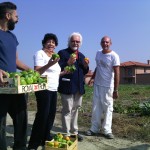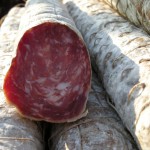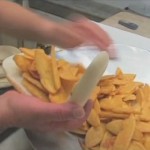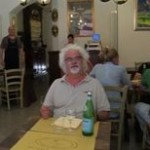A special kind of peppers that you can taste in Oltrepò Pavese
Italian Food: Strolghino and Culatello of Zibello
Flavours and products in the countryside of Parma
From the grocer to the producer: a tour in Zibello for those who like Italian ham and salami.
This real slow tour starts in the area of Parma. On a common Sunday I went to a plant and flower market and, in particular, to the Garden-Parma di Lemignano. Here there’s a small grocer called “Campagna Amica” (that is land is a friend). Nowadays in Italy there are a lot of shops like that, connected with many farms. In this way, in the process of production chain they bring the produce from the land directly to the consumer. They sell fruits, vegetables and also local products made at the farms: a more accessible version of the GAS, Gruppi di Acquisto Solidale (ethical purchasing groups). The project is promoted and sponsored by Coldiretti (the leading organization of farmers).
The produce usually comes straight from the surrounding lands, but this is not an obligatory requirement, so many products often come also from other regions. Here in Lemignano I learnt something more about the produce, about the tomatoes, which are rich in lycopene (the production of tomatoes is bigger in the area around Parma than in Southern Italy!), about pasta, jams, aromatic vinegar, flowers and vegetables and, most of all, about a strange salami, the Strolghino from Zibello. It is a rare and noble sausage that, just as if it was a human finger, showed me the way to go on a unique journey…
The strolghino salami is produced using the remains from the culatello, that is the most precious part of the ham. It is produced in the area of Parma, in particular in Zibello, a little village nearby the Po river. Those precious pork remains are put into thin sausage skins and then everything must be consumed at most within a month, because that lean meat cannot be conserved for a too long period of time. Tasting the strolghino we can predict the taste of the culatelli, its “elder brothers”, which are the pride of this area. It is not surprising then to find out about the Culatello fair in Zibello: here every year people celebrate it with the longest salami in the world, a strolghino which is longer than 300 metres!
November Pork
But there is more. In autumn in different parts of the world people celebrate the Oktober Fest. Here people love celebrating the November Pork: sausage and wine stands and target shooting using a salami. This fair is more than a simple feast (with our cholesterol levels that hit the roof). It is the perfect intersection among land, climate and customs. The Celts and the Gauls used to feed pork proteins to their Roman Legions, their secret weapon to fight Hannibal.
Rino Parenti has worked the pork for 40 years. He is the Magician of the Culatello, one of the main actor producing the longest strolghino in the world. He lets me visit his workplace and shows me the different techniques to cut the culatello, starting with the leg. Then he salts and presses the culatello, and trusses it like a salami. The culatello matures in different places, perfectly supervised thanks to a technology able to determine its temperature and humidity. Moreover, the air in Zibello, due to its closeness to the Po river, helps the culatello to mature in a very unique way. We are not far from Brescello, the place of birth of Guareschi, who used to celebrate Lambrusco wine and culatello in his novels.
Patrizio
Video Full Text: Strolghino and Culatello of Zibello
A slow tour through the countryside of Parma in search of flavours and products.
In Zibello’s town square they are making the world’s longest Strolghino salami.
It’s made from the trimmings of Culatello.
The Strolghino is laid down very gently.
If it breaks it will turn out to be a disastrous season!
The votive offering is only complete when some vegetables are laid on top of it.
Cabbage, carrot, potato and plum.
Clear symbols of fertility!
The casing is natural and can be eaten!
How it is made is a secret.
The pork butcher, Rino Parenti, is the grand master Culatello of Zibello maker.
The Civil Protection Agency takes the official measurements.
338 metres – confirmed. It’s a record!
So what’s behind this need to set a record?
To better one’s life and never stand still is something we have to do.
The number of Culatellos produced every year in Zibello has risen from 20,000 to 30 – 40,000.
Making Culatello is like making love; it needs to be done gently.
So what does it take to make Culatello?
So now Rino Parenti reveals some of his secrets and shows us how it’s done.
Culatello is salted, rubbed, tied and prepared for ageing.
It is aged in the “conservatory” for at least 14 months.
Verdi’s arias and the air and fog here is what makes Culatello unique.
Is the fog in Zibello different from that in Polesine?
The fog isn’t but the currents of air are.
Zibello is 20 metres from the Po River, but the air approaches from the rear.
Ageing occurs naturally, simply by opening the windows.
This Culatello is the finished product.
The real secret behind Culatello is something else: playing music to it!
Rino Parenti comes here to play his accordion.
The ideal music for Culatello as it ages is that for ballroom dancing.
And Verdi’s as well….
In the land of Verdi, music, the fog and the pig all combine to create a unique harmony.
What were you singing?
So it’s true!
Verdi based his triumphal march in Aida on what he’d heard the cooked-apple sellers singing!














